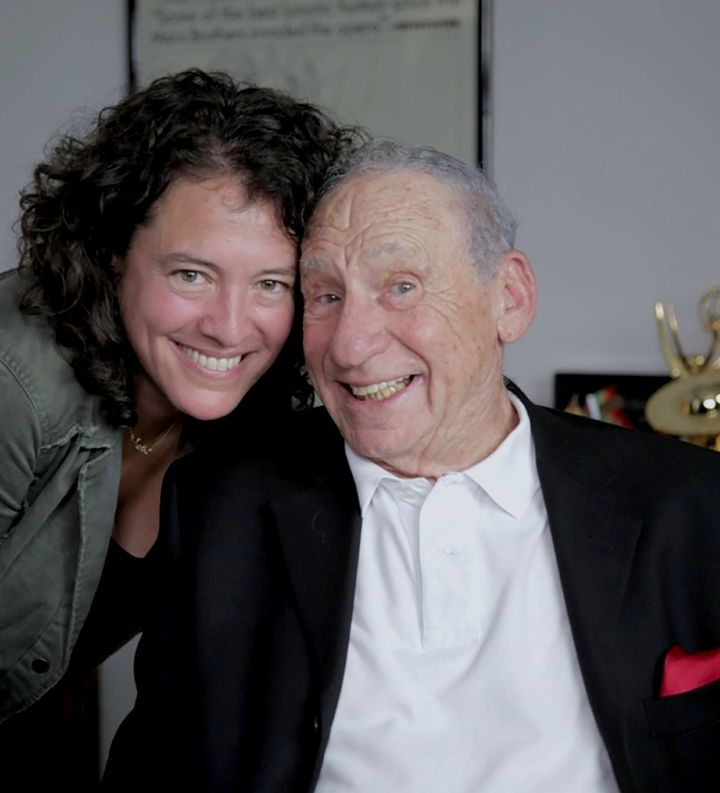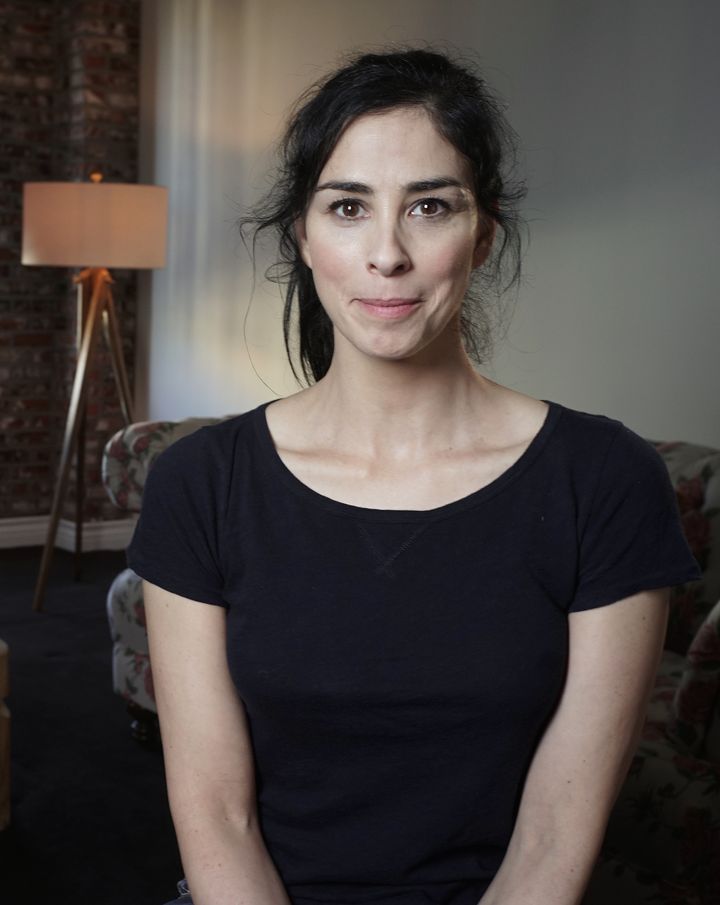
The director with one of her film’s subjects
In 1990 Ferne Pearlstein had a conversation that would haunt her for years. Art Spiegelman’s Pulitzer Prize-winning Maus, a comic take on the Holocaust in graphic novel form long before such books had entered the cultural lexicon, had just been published. Pearlstein and her friend Kent Kirshenbaum were marveling about it to a survivor of the camps when the woman became angry. “There’s nothing funny about the Holocaust,” she said. “You can’t cover it in the funny pages.”
Almost three decades later Pearlstein continues that debate with The Last Laugh, a deft, provocative exploration of where the line should—and sometimes can’t—be drawn in filtering taboo topics through the lens of comedy.
A blend of scabrous humor, insight, and potent emotion, the documentary’s construction is fluid and complex—a testament to the power of tragedy plus lots of time. Balancing conversations with comedians (including Sarah Silverman, Mel Brooks, Harry Shearer, Judy Gold, David Cross, Lisa Lampanelli, and Susie Essman); directors (Larry Charles and Rob Reiner); and writers (Alan Zweibel, Etgar Keret, and Shalom Auslander), Last Laugh interweaves their wry and acid perceptions with pointed pop culture excerpts and not-to-be-believed footage like Jerry Lewis’s notorious pre–Life Is Beautiful camps-clown turn and Louis C.K. in an eye-opening talk-show bit. Propelling the film forward are vibrant vérité scenes from the current lives of several Holocaust survivors, moments that give Last Laugh its beating heart.
Pearlstein could not have predicted how long it would take from that first germ of inspiration to the film’s arrival at the TriBeCa Film Festival last season, but she credits it as essential to the strength of the finished work. “The time it took to make it, made it a much better film. Not just because how we all deal with satire in relation to difficult topics has evolved,” but because the process of getting funding utlimately dictated a more effective way of having to work. “I’d shoot a bit, edit, run out of money, get some more, do it again,” she recalls. “It was like a painting where you go back to it every six months and add another layer.”
After that first inciting conversation, Pearlstein and Kirshenbaum had gone their separate ways, she to film school, and he to pursue a PhD, where he wrote a 25-page academic philosophical treatise called “The Last Laugh: Humor and the Holocaust.” ”Make this into a movie,” he told her three years later when they met again. “And I knew I would,” recalls Pearlstein. “But I also knew I wasn’t a mature enough filmmaker yet to make it right away.”
Five years later she’d garnered enough credits as a cinematographer to be hired by a man named Robert Edwards to shoot a film he’d written. “Two and a half days later we were dating—and planning our next film together.” Transforming Kirshenbaum’s treatise was top of the list, and they set off to make their Holocaust comedy. Then Life Is Beautiful came out.
Worried that movie “would take over the conversation,” Pearlstein and Edwards put the project on hold. Two years later they tried again—and kept trying. “It was impossible to get funding for this film, impossible,” she recalls. Even the most likely producing candidates, people known for their taboo humor, wouldn’t take the leap. In 2006 Pearlstein went to see the film The Aristocrats, about the filthiest joke ever told—“and on the screen is Gilbert Gottfried making 9/11 jokes. And I thought, If they can laugh at this, they’re ready for my film.” She redoubled her efforts to get it made, but another five years passed, to no avail.
Then, shooting a film for a German filmmaker friend, she met one of its funders, a Jewish woman with a “really dark sense of humor” who primarily invested in causes rather than movies. Two years later at that film’s premiere, Pearlstein met her again and blurted out her story: how ”every time we approached a producer or a funder, they’d say, ‘Great idea! Let us know when somebody else says yes.’” (Uberproducer Bernie Brillstein, true to the film’s spirit, told them: “It’s a fantastic idea! You don’t have a Chinaman’s chance in hell of making it.”)
At the premiere, fascinated by “the idea of artists and comedians and survivors,” the unlikely funder proposed a lunch date. “So my husband, Robert Edwards, and I, and our five-month-old baby in her car seat go and meet this woman—and I’ve got this thick proposal tucked under my daughter’s butt in the car seat. We’re sitting at the table and I go to reach for this proposal from under my daughter’s butt. And as I’m doing that she says, ‘So. Would $100,000 get you started?’” Pearlstein pushed the proposal back under her daughter’s behind. “Yes. Yes it would,” she said. With the exception of a small grant from the New York State Council of the Arts, in fact, the woman would end up funding the whole film, with Pearlstein serving as its unpaid cinematographer, writer, editor, and director.
That first break came in the end of July of 2011. Soon after, Pearlstein and her husband sent a “massive” list of comedians to Edwards’ CAA agent, pleading, “Is there anyone you can help us with on this list?” A half hour later the agent called. “Rob Reiner says he’ll do it a week from Wednesday.” Thrilled—and caught off guard without a crew or anything in place for shooting—Pearlstein quickly set up a two-week shoot around that interview.
More magic would come to pass, a tribute to her persistence. At the top of her giant list were Mel Brooks and Sarah Silverman. “I knew I couldn’t make the film without them,” Pearlstein says. “So I sort of just kept finding new ways to get to them if they said no. I knew there were certain people that just never do interviews, like Woody Allen, like Larry David. When I got no’s from them, it was different than the first time I got a no from Mel Brooks. [For him] I was like, I gotta find another creative way.” In fact she did get a yes from Larry David, though 48 hours later “he came to his senses.” On the phone he’d told her, ’Look, I’m only going to talk about the work. I’m not going to intellectualize about all these issues.’” Larry Charles, who directed the “Survivor” episode of Curb You Enthusiasm that’s in the film, had the opposite reaction: “He only wanted to intellectualize, he didn’t want to do a surface-level thing.” Make it work was Pearlstein’s mantra, so complementing the scenes in which Charles intellectualizes in the film is Larry David, his ethos clearly represented in scenes from Curb Your Enthusiasm and Seinfeld.
Another comic at the top of her list came through: “Joan Rivers was one of the first people to say yes,” says Pearlstein, but the comedian’s schedule was so packed they weren’t able to find an opening until at long last a date was procured: October 1. Rivers died two weeks before that shoot. Making it work, the filmmaker channeled Rivers through especially pointed clips: “She’s even having a back and forth with [the Anti-Defamation League’s] Abe Foxman from the beyond,” exclaims Pearlstein. “He’s talking to the sky. That to me is one of the most poignant moments in the film.”
Over the years trying to make Last Laugh, the filmmaker had accumulated a list of contacts. One of them, Hanala Sagal, author of My Parents Went Through the Holocaust and All I Got Was This Lousy T-Shirt, introduced her to survivor Renee Firestone, the activist who embues the film with its core power and some of its most heartening surprises. “‘I’m looking to do an interview with a survivor who doesn’t think it’s okay to laugh; I’m looking for a survivor who does think it’s okay to laugh,’” Pearlstein told Sagal, “‘and I’m looking to children of survivors’—because I’d started to uncover this really dark inside sense of humor where they could sort of poke fun at—not their parents’ experiences in the war, but at their parents, as more quirky than their American friends and their parents. Their lives were different and odd, and they would make funny jokes about that. But they’re so protective, understandably, that’s it really hard to get them to tell the jokes on camera.” (That wasn’t a problem with the filter-free Sagal.)
One doesn’t expect an elderly Holocaust survivor to be a fiery advocate against genocide worldwide, but “that’s why I wanted Renee,” says Pearlstein. “Because she was so open and so open-minded and not just, Never again the Holocaust. She was Never again all of this stuff—that was really important to me. She went to Rwanda on the eve of her 90th birthday to counsel survivors!”
Other survivors add to the film’s complex dynamic. Robert Clary—Hogan’s Heroes’ LeBeau, ironically himself a survivor of the camps, provides a moving meta boost, and Elly Gross, a woman who sees no humor in anything, serves in stark contrast to Firestone, the woman who believes it is our duty to live life to the fullest for all those people who aren’t here to do so. “That is literally what Renee thinks,” says Pearlstein. “She sees it as her job.” Gross’s years in the camps cast a shadow over her life that obliterates any possibility of finding joy in life, of not letting the Nazis “win.” Says Pearlstein, “Renee was born with the spirit she was born with. She came from a wonderful family, with a wonderful background; she was living in a community where her friends were Jewish and non-Jewish, and she was Czech but from under the Hungarian Empire. They were thrown into Auschwitz in the last year of the war—she was already close to 20, so she had happy memories from before this. Elly was born in Romania, she was 15 when she was thrown in the camps, she doesn’t have one positive memory of her life before the camps. She was spit upon from the moment she was born. I can relate to both of them,” says Pearlstein.
Now that we have a president whose penchant for hate speech has lowered the bar as to what’s acceptable, Pearlstein recognizes the shifting landscape in which her movie has arrived. “The comparisons are there. Now it’s more oblique,” she says. “And it’s more universal.” Two days after last November’s Black Tuesday, she saw a change in the film’s reception: “I had nine back-to-back film festivals. And during those two weeks it was not as funny of a film. Opening night at the High Falls Film Festival in Rochester, the programmer said to me, ‘A few nights ago I watched a different movie than I watched tonight.’”
No one could have predicted we’d come to a time when comparing someone to a Nazi would no longer be hyperbole. Pearlstein’s film has become especially timely, and its parallels to totalitarian Germany truly chilling. But “people need to laugh,” says Pearlstein. “It’s a little more funny again. But I tell you, those first two weeks, it was like a serious film. And there are serious parts to my movie, but it was the funny parts that were serious. It hit too close to home.”
After decades of striving to explore the question she’d never fully forgotten, the filmmaker is grateful for the chance to open a new dialogue. “I never imagined in my wildest dreams—I mean, I always hoped there would be an interesting discussion from this, but now it’s beyond fascinating. People just want to talk about it.” Ferne Pearlstein considers this latest twist in her long adventure. “I’m really proud that it’s causing people to think about what we’re doing.”

The alleged Sarah Silverman
